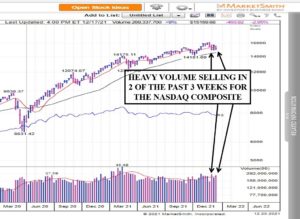Since the April 2020 low, I’ve been bullish on the markets for two main reasons: The strong technicals and the accommodative Fed. I started writing articles around that time saying that even though the pandemic will get worse, “it doesn’t mean the stock market has to go lower.” Over the past two weeks, these two factors have changed, and the market is telling me to be defensive until we see healthier conditions.
The technicals I am referring to include the major indexes and individual stocks. The 10-week moving average is traditionally an area of institutional support. In two of the past three weeks, the Nasdaq Composite has seen heavy volume selling and the index is now below this level. It doesn’t mean that we have to decline, but it likely means the index will need time to repair before we see another sustained uptrend.
Regarding individual stocks, it’s usually a healthy sign when growth stocks are building quality technical bases and breaking out on strong volume. Right now, there are very few stocks that fit these criteria. There are definitely stocks acting well, but most are coming from sectors such as Utilities (XLU), Healthcare (XLV), and Consumer Staples (XLP). This is not inspiring for a sustained uptrend because these are considered “risk off” and defensive sectors.
In the spring of 2020, the Fed created an incredibly accommodative environment for equities. They kept interest rates near zero and flooded the system with liquidity. They made more Treasury purchases in the six weeks following the pandemic than they did in the nine years combined between 2009-2018. They continued with $120 billion in monthly bond purchases. In the past two weeks, all this has changed, and the Fed’s tone has become more hawkish.
They are reducing liquidity by “tapering” their bond purchases and doing so at a faster pace than the market was expecting just two weeks ago. They are also facing this increasing problem of inflation. The most recent consumer price index (CPI) report showed that inflation accelerated at its fastest pace since 1982. As a result, the market is now pricing in three rate hikes in 2022. The chart below from Jim Bianco of Bianco Research shows when the market is expecting these rate hikes.
Whether the Fed actually raises rates or not doesn’t matter at this point. We could see a fall of 2018 scenario where the market drops because it’s expecting a rate-tightening cycle, and then the Fed changes their tune and decides that rate hikes are not needed. The main point is that the Fed is no longer accommodative and market participants should be defensive until we get more clarity or at least until the Fed shifts back to a more dovish stance. There’s a reason why Wall Street legend Martin Zweig created the phrase “Don’t fight the Fed.”
Bottom line, the main reasons to be bullish since the April 2020 low have changed over the past two weeks and investors should be defensive until market conditions improve. By defensive, I am referring to sticking to a loss cutting policy when any of your positions break down, raising some cash for healthier times, and using smaller positions to minimize volatility. Of course, we can still have some decent up days and see some seasonal strength towards the end of the year. However, I’m looking for a sustained uptrend and my work is telling me that it is not a high probability situation right now. Good luck!
I can be reached at: jfahmy@zorcapital.com
Disclaimer: This information is issued solely for informational and educational purposes and does not constitute an offer to sell or a solicitation of an offer to buy securities. None of the information contained on this site constitutes a recommendation that any particular security, portfolio of securities, transaction, or investment strategy is suitable for any specific person. From time to time, the content creator or its affiliates may hold positions or other interests in securities mentioned on this site. The stocks presented are not to be considered a recommendation to buy any stock. This material does not take into account your particular investment objectives. Investors should consult their own financial or investment adviser before trading or acting upon any information provided. Past performance is not indicative of future results.



